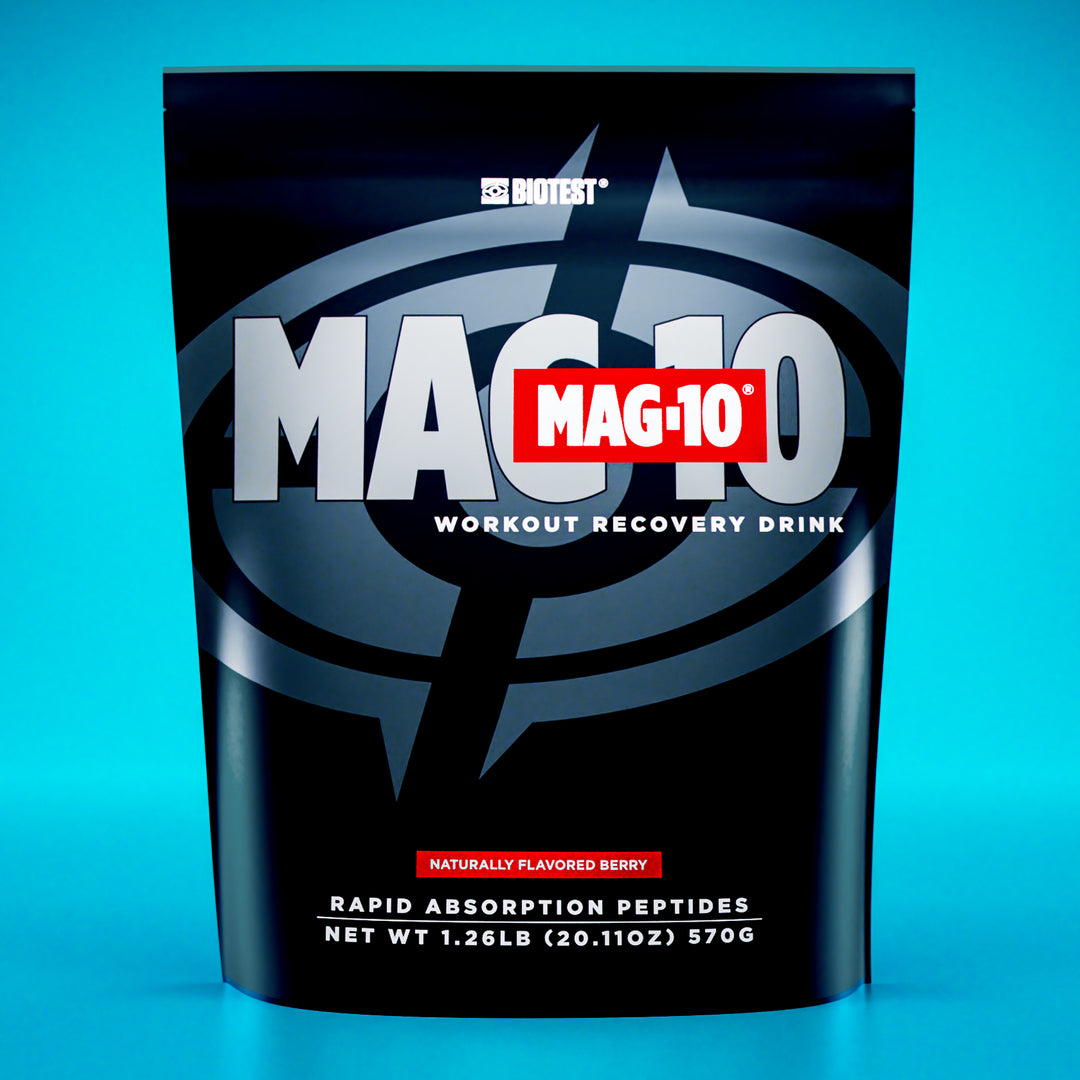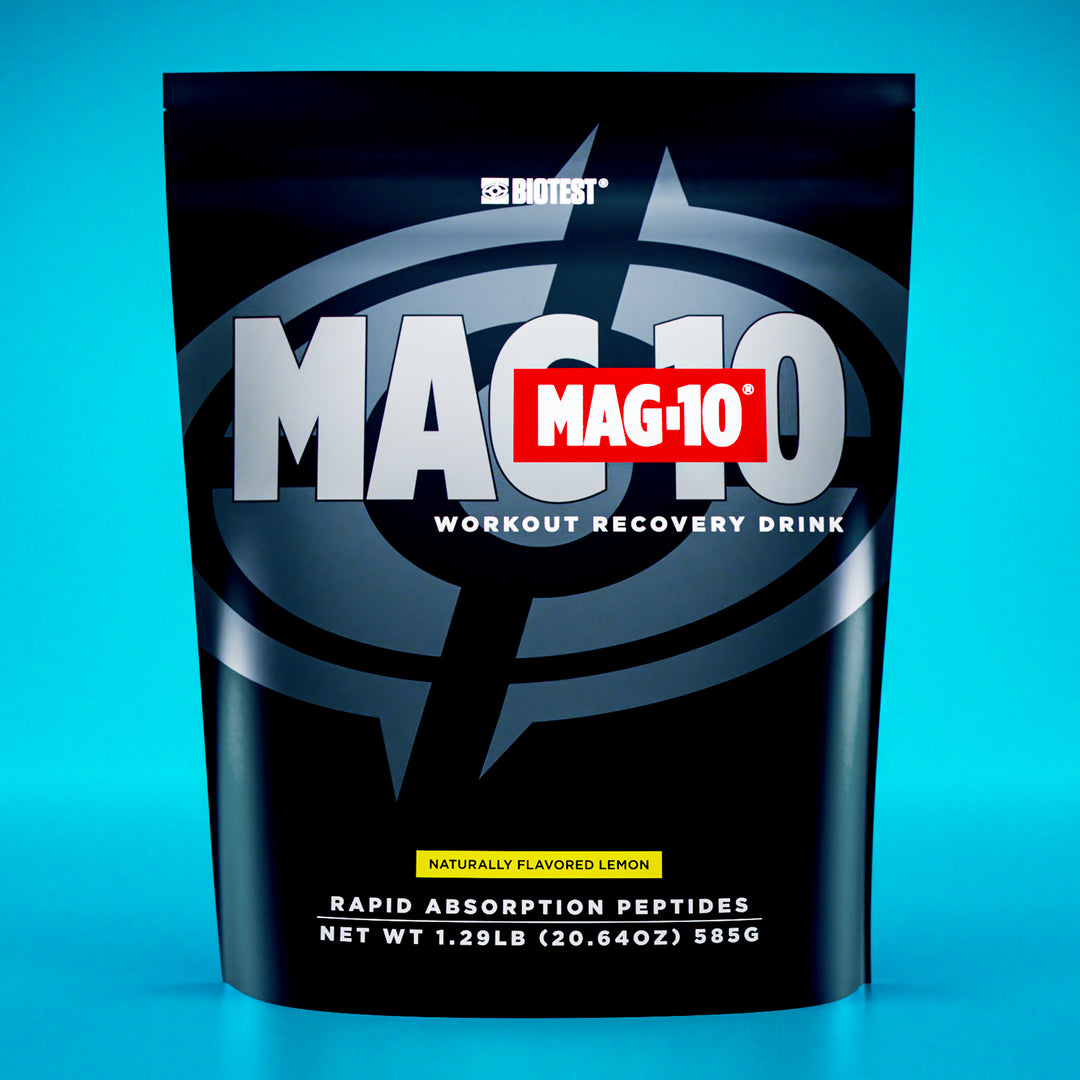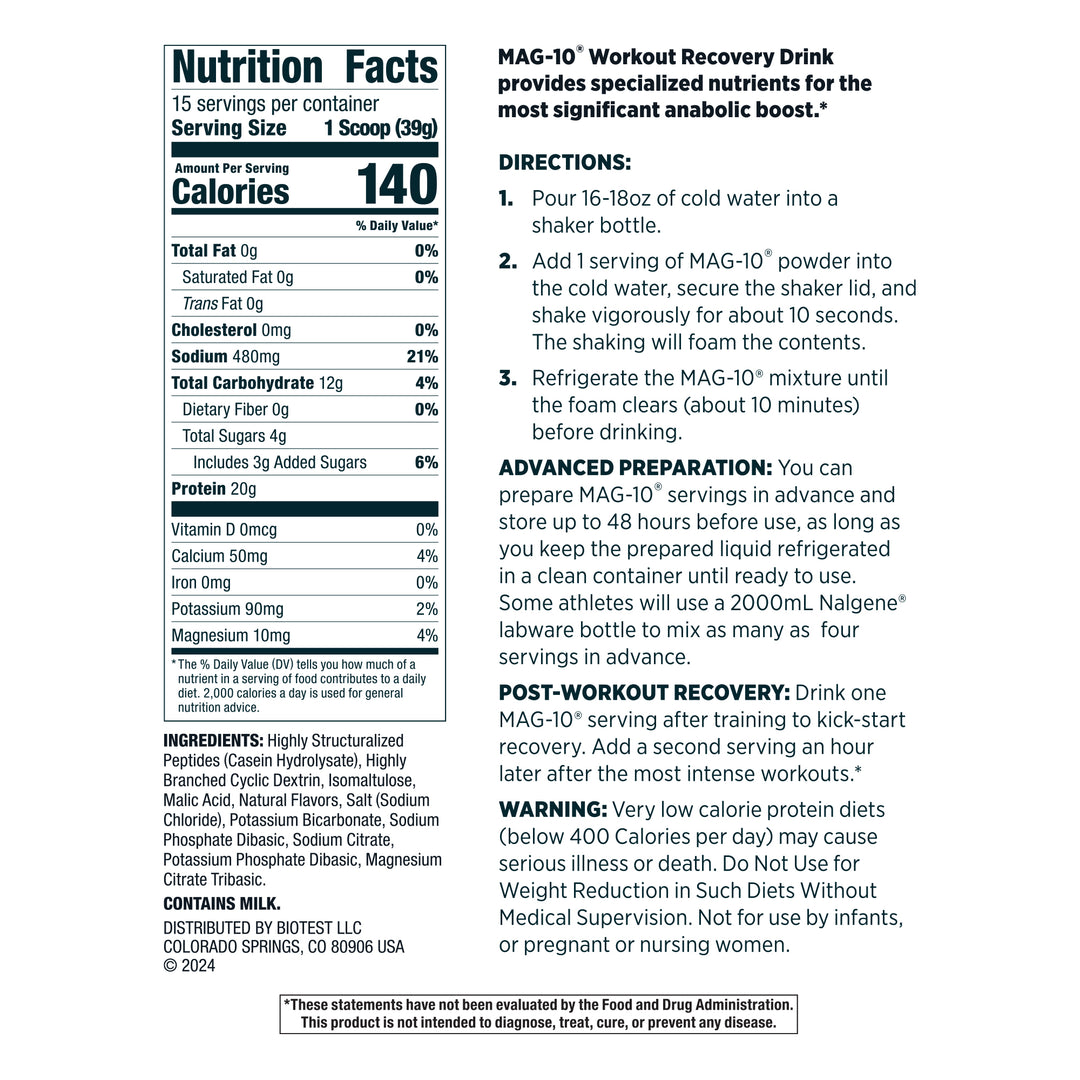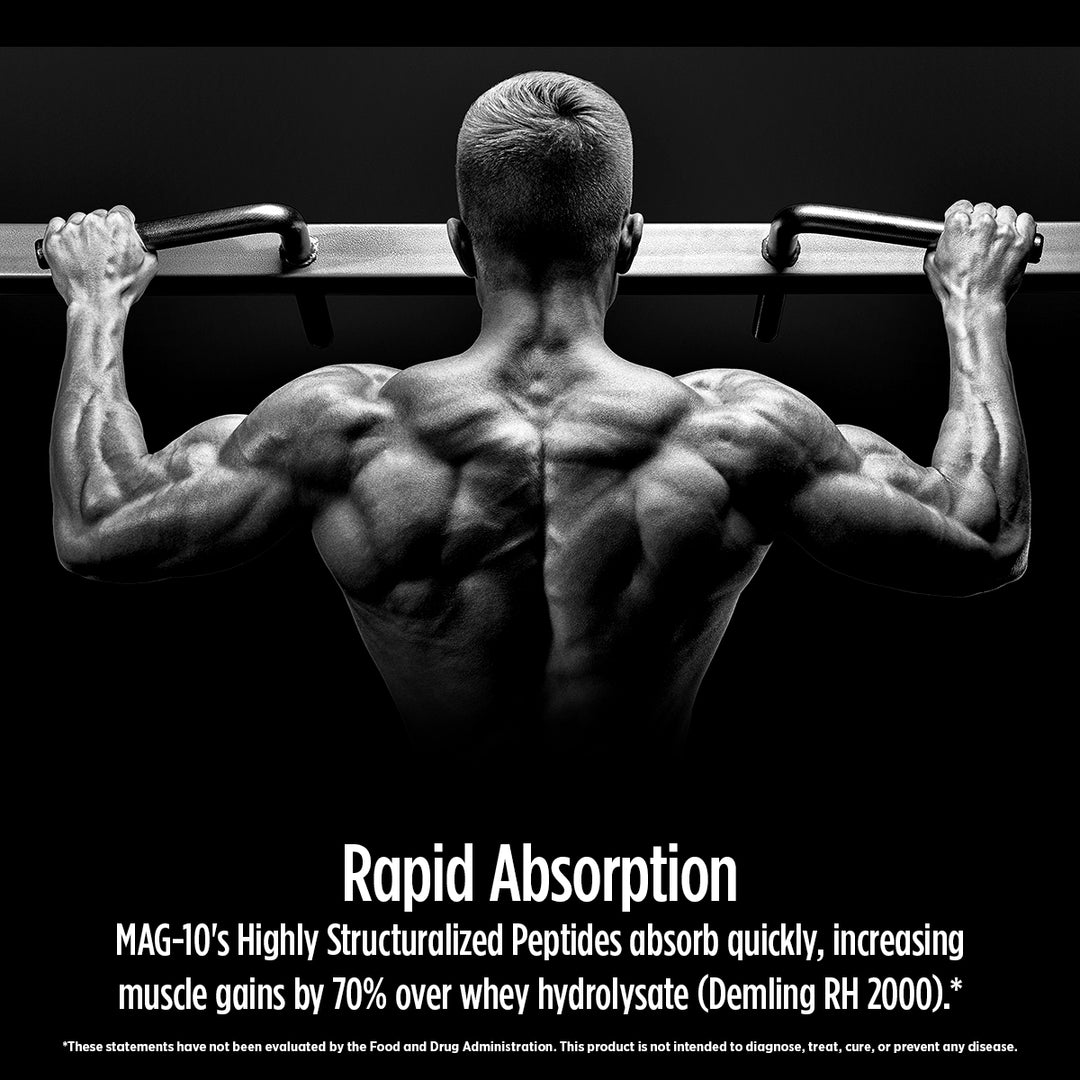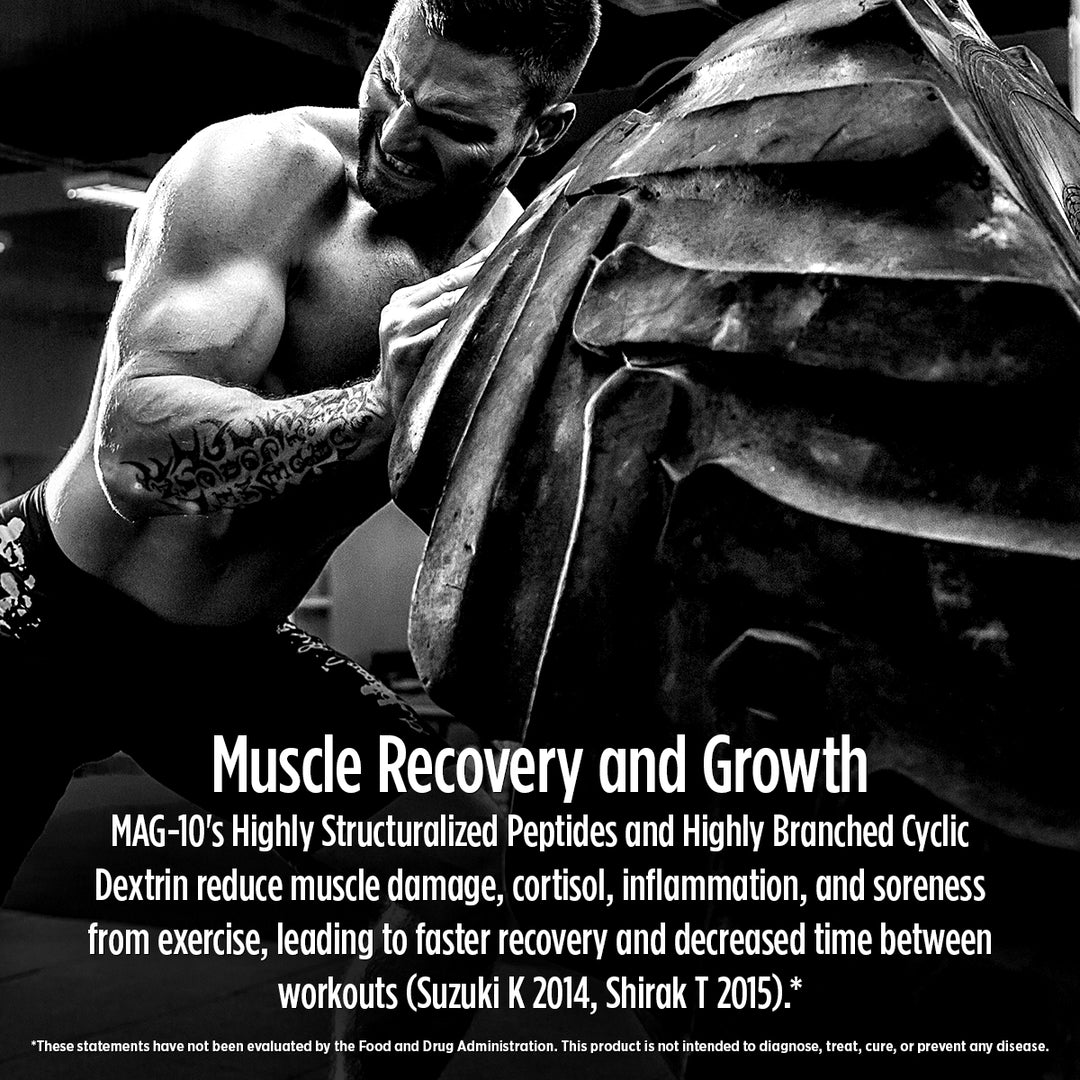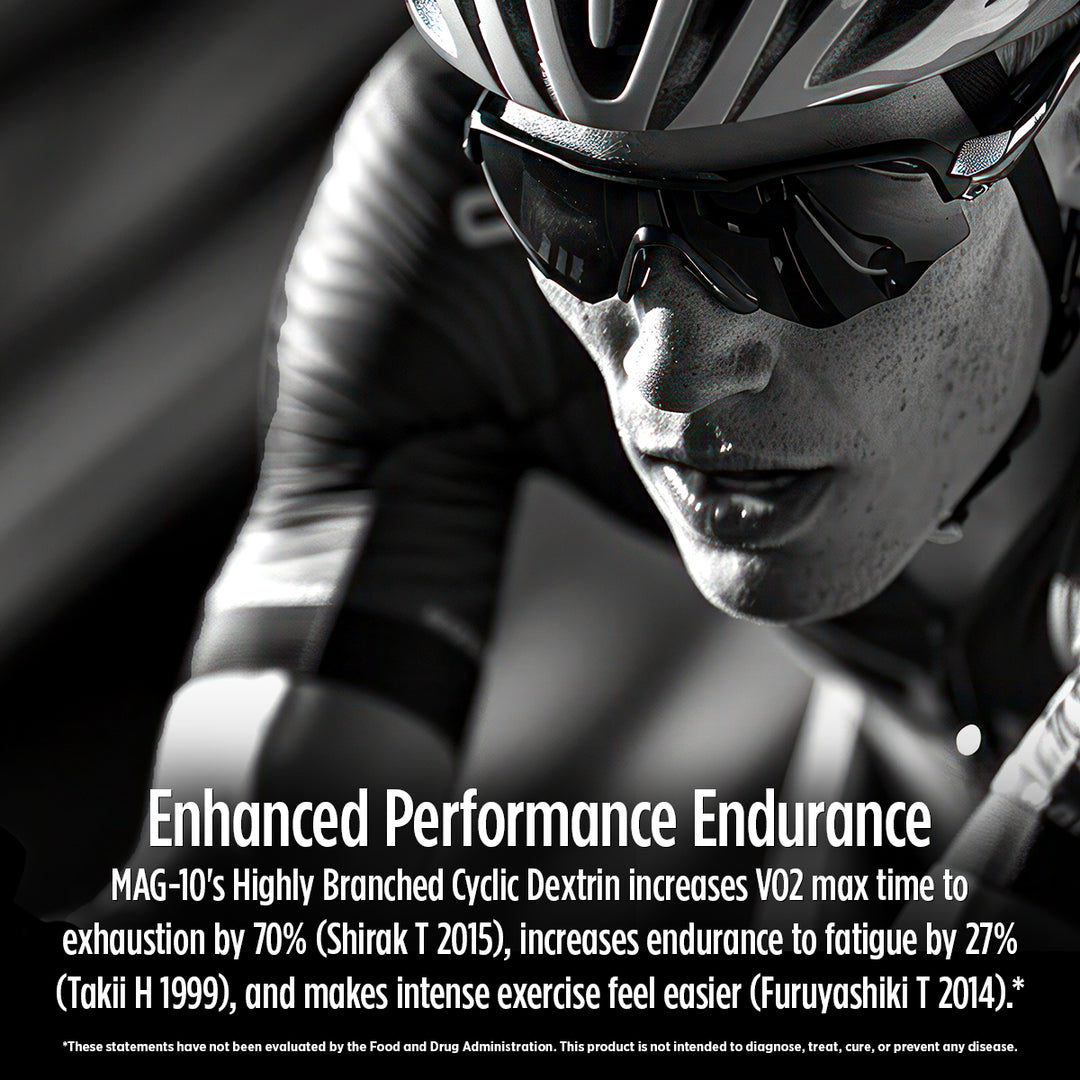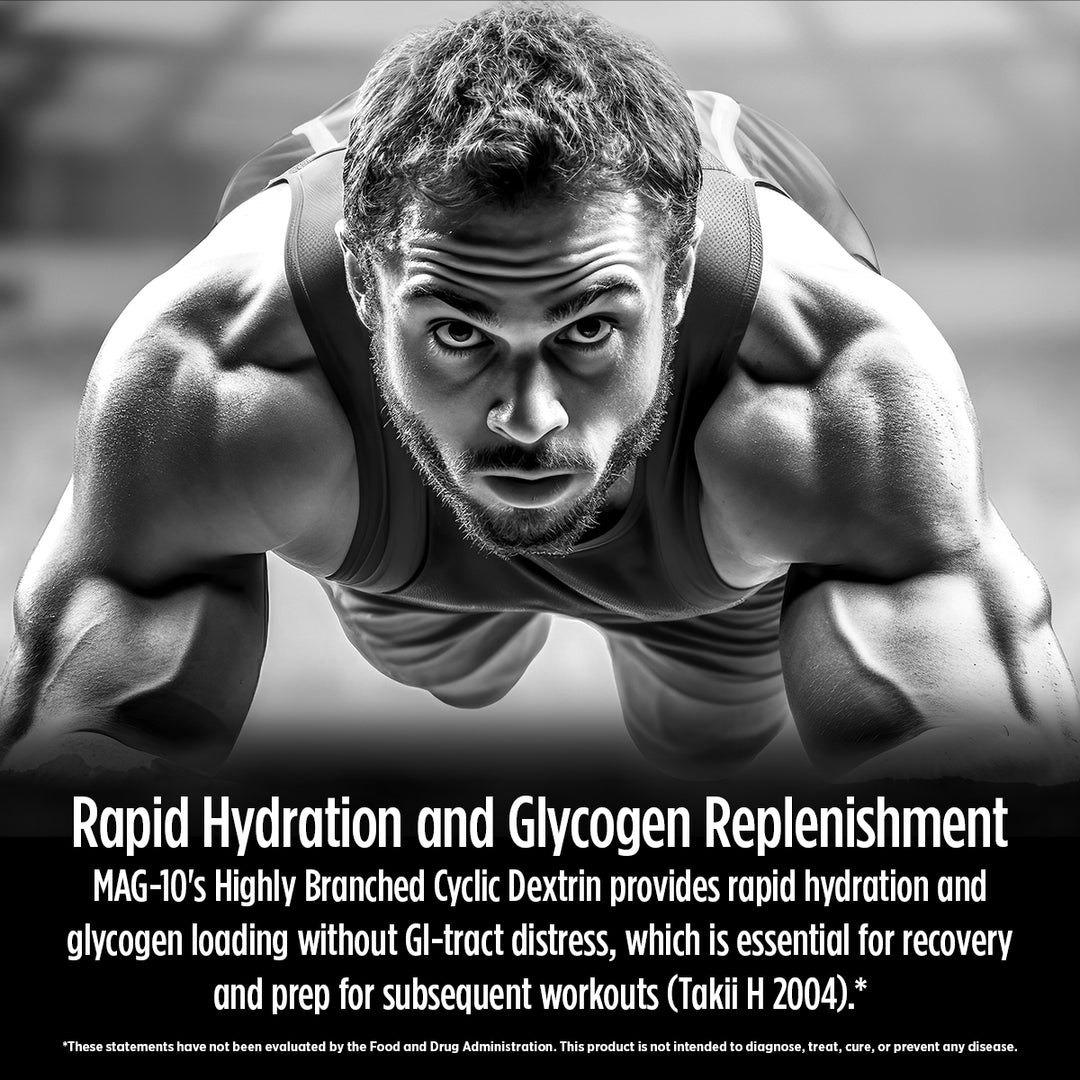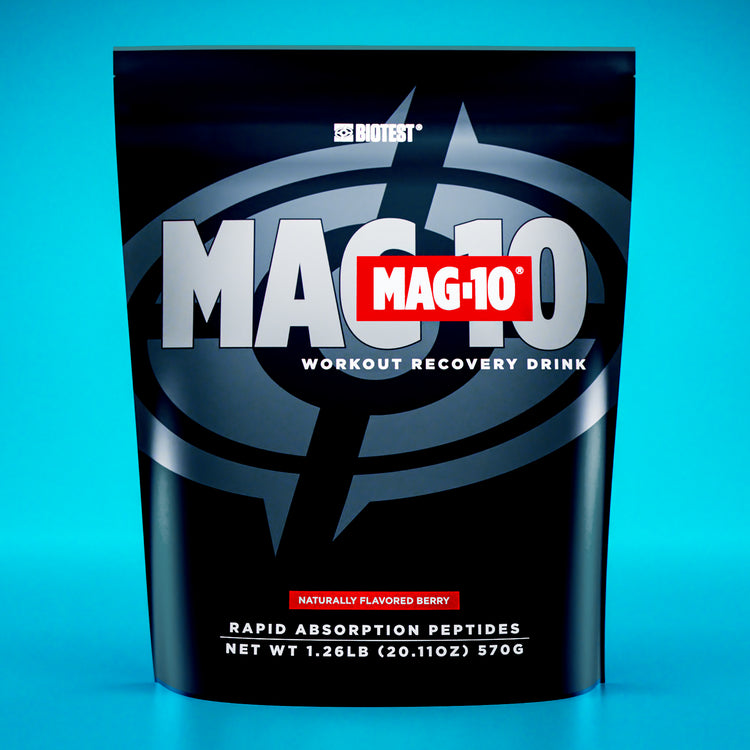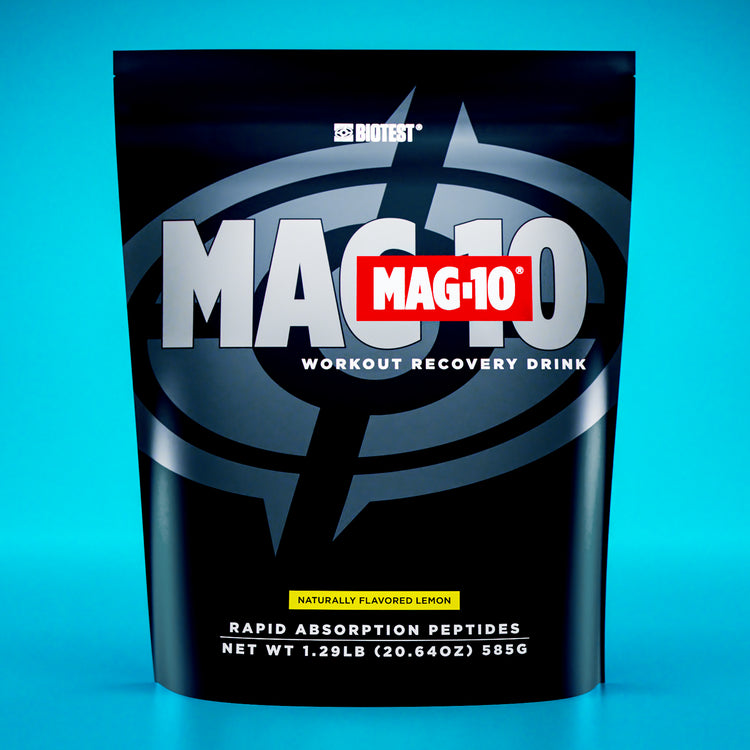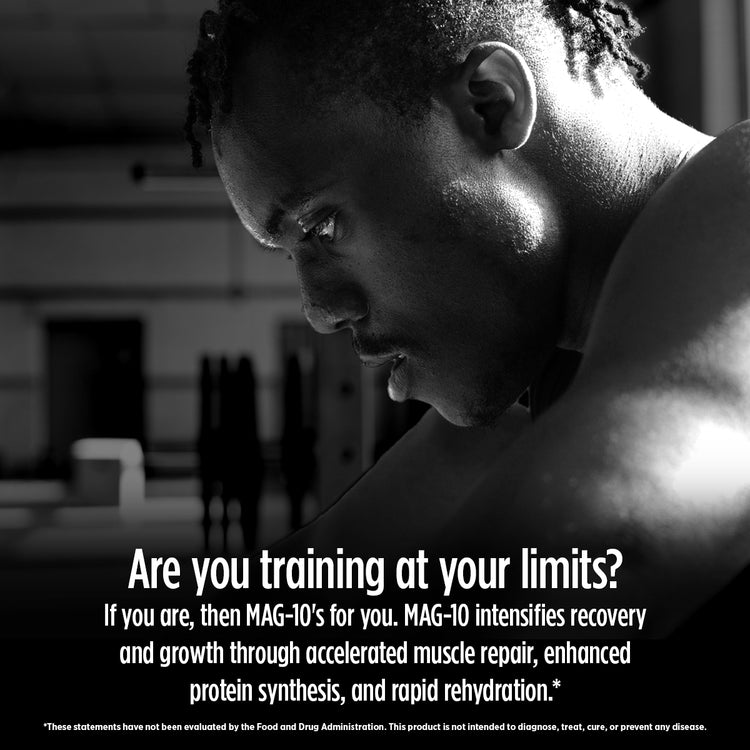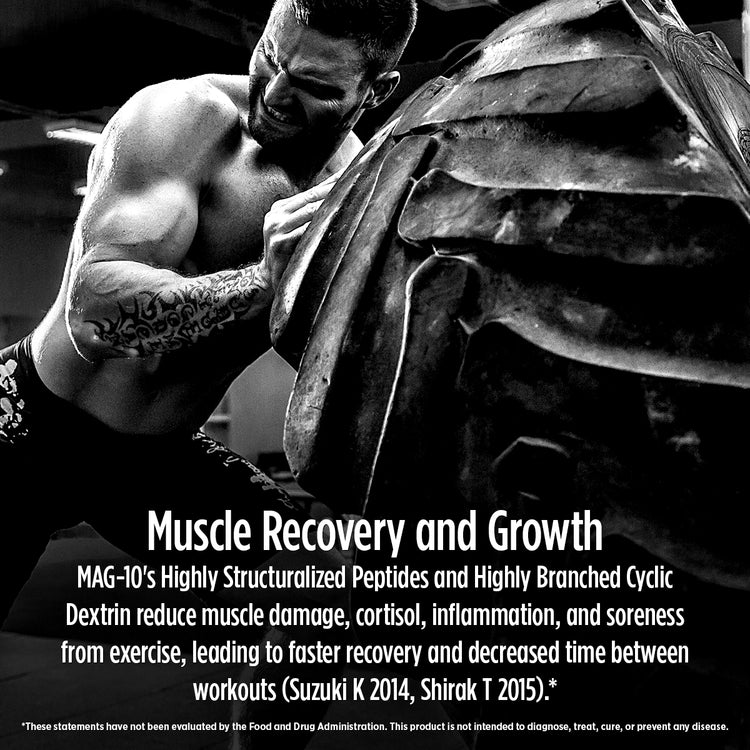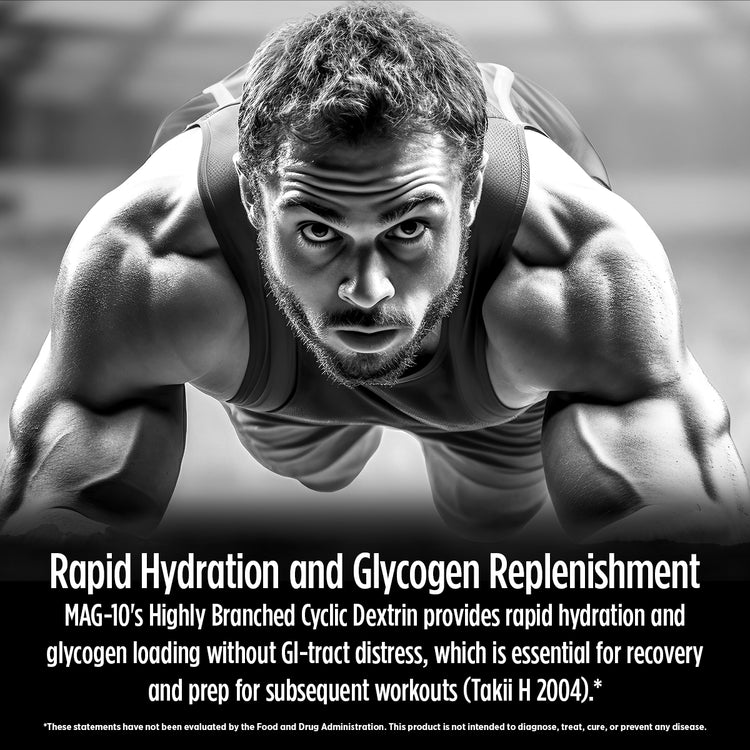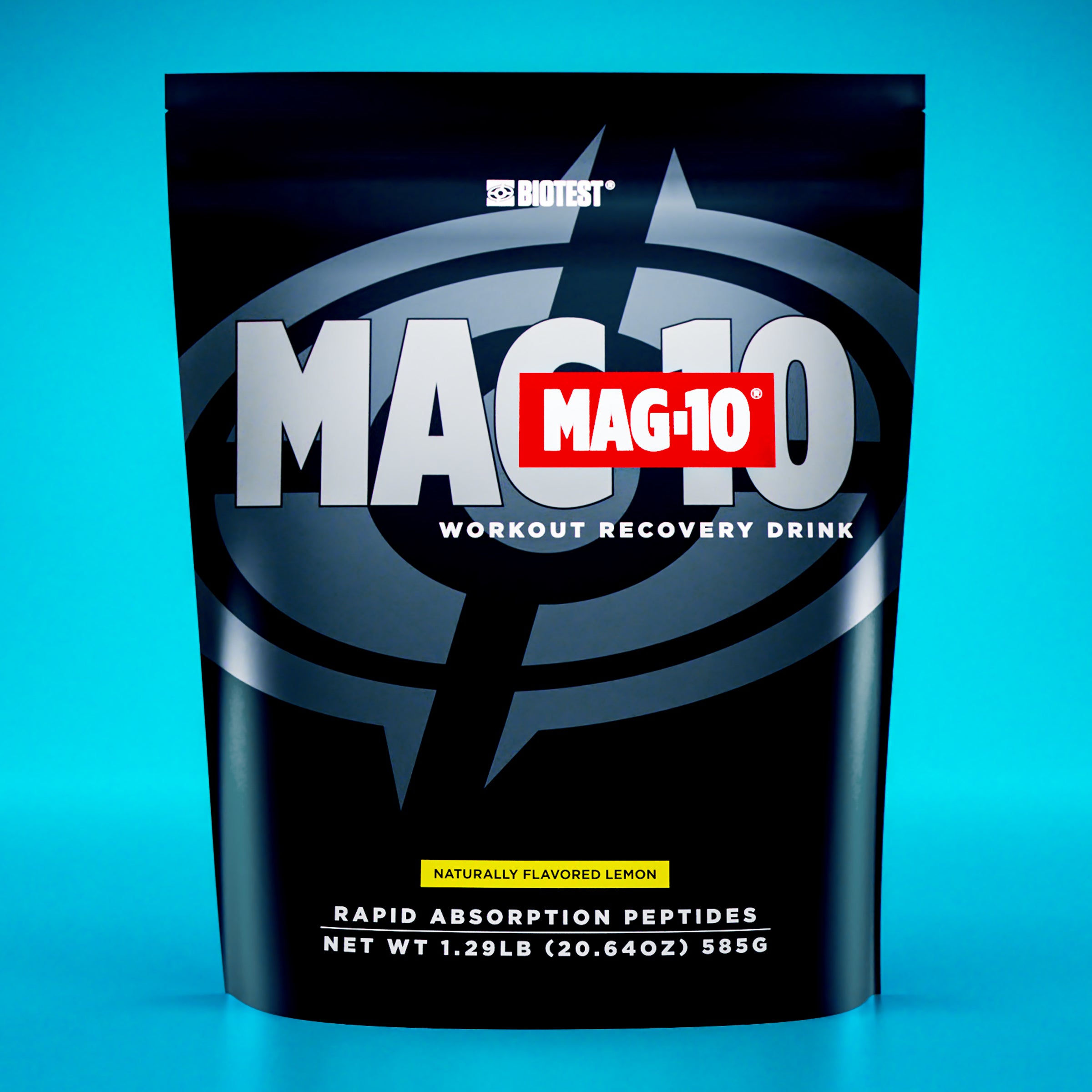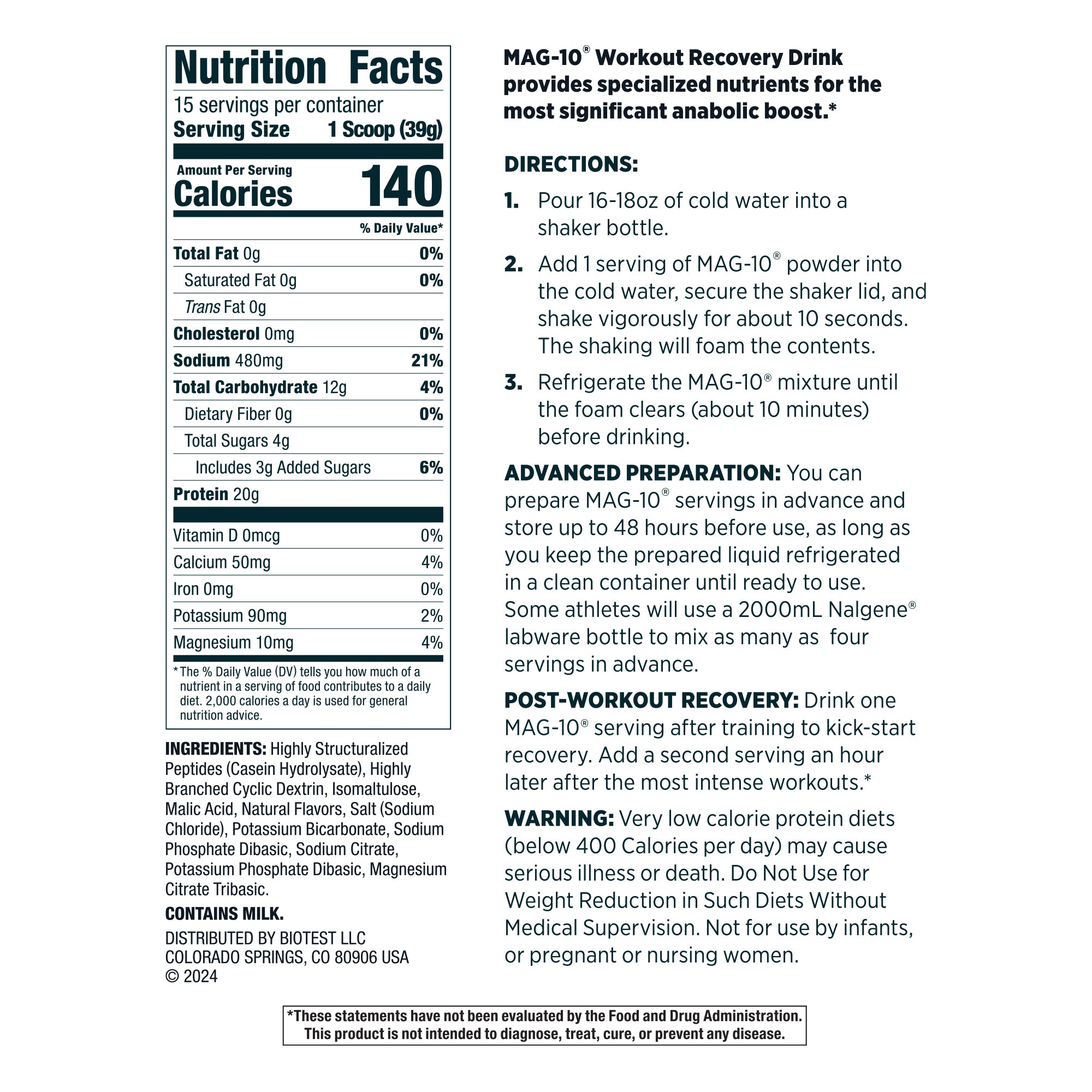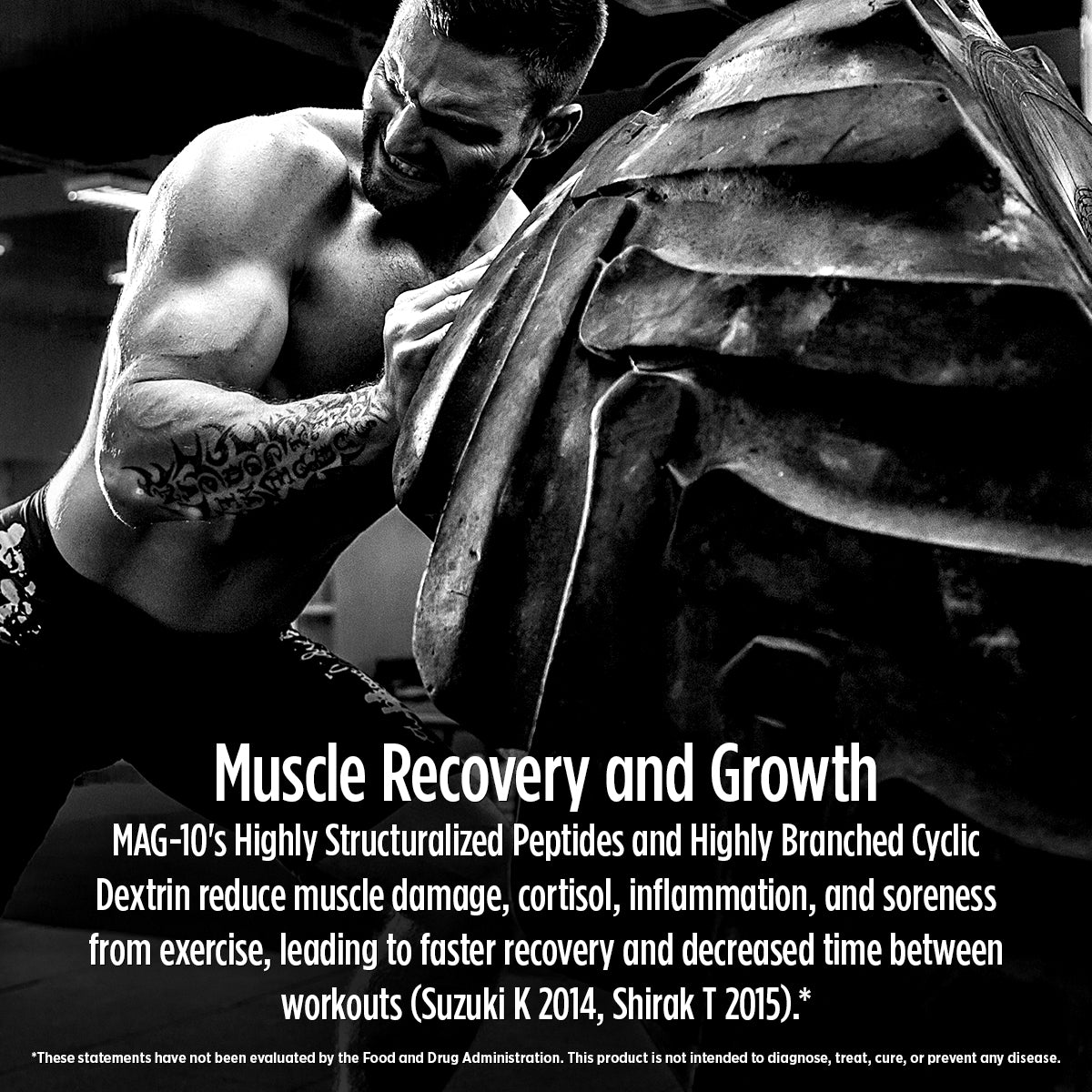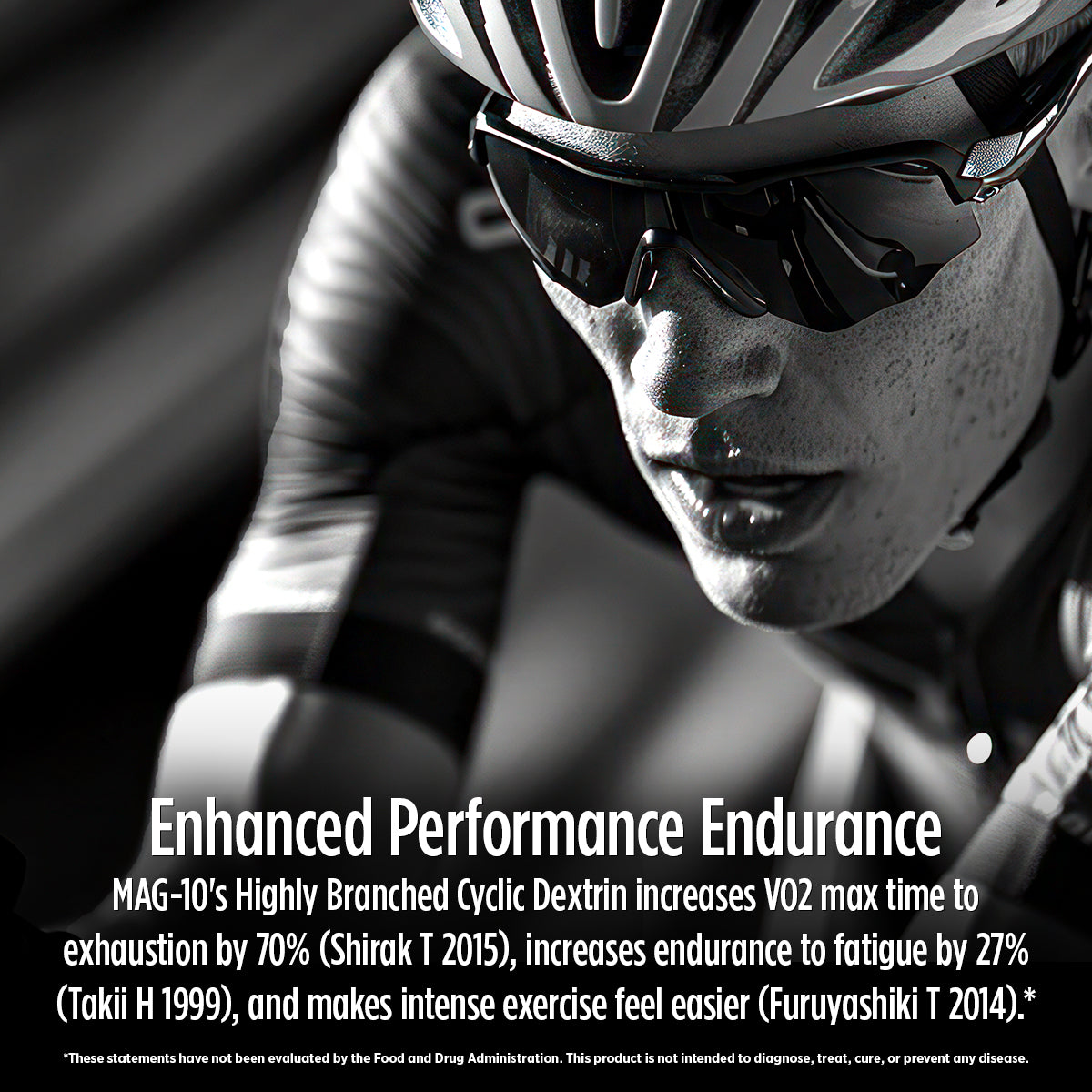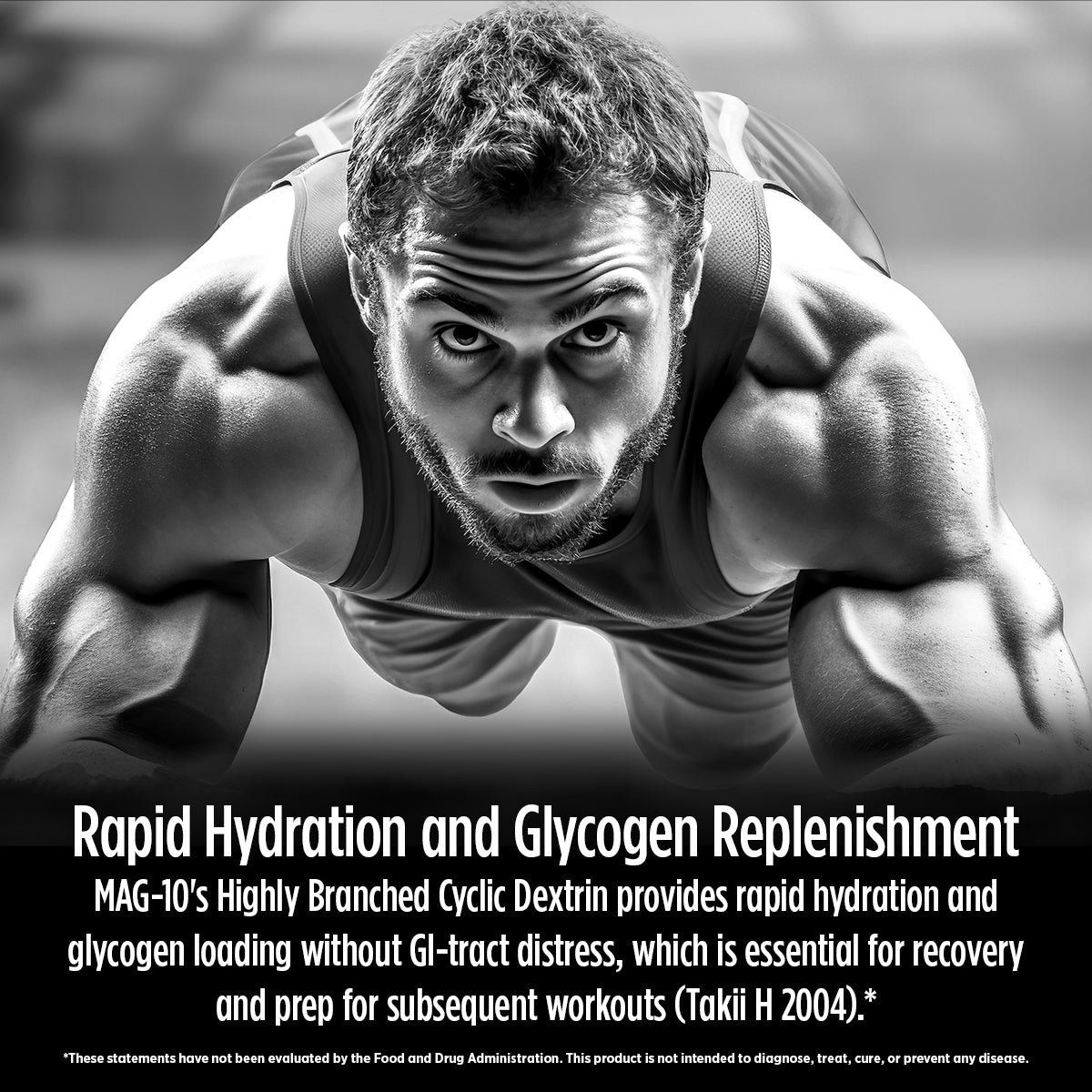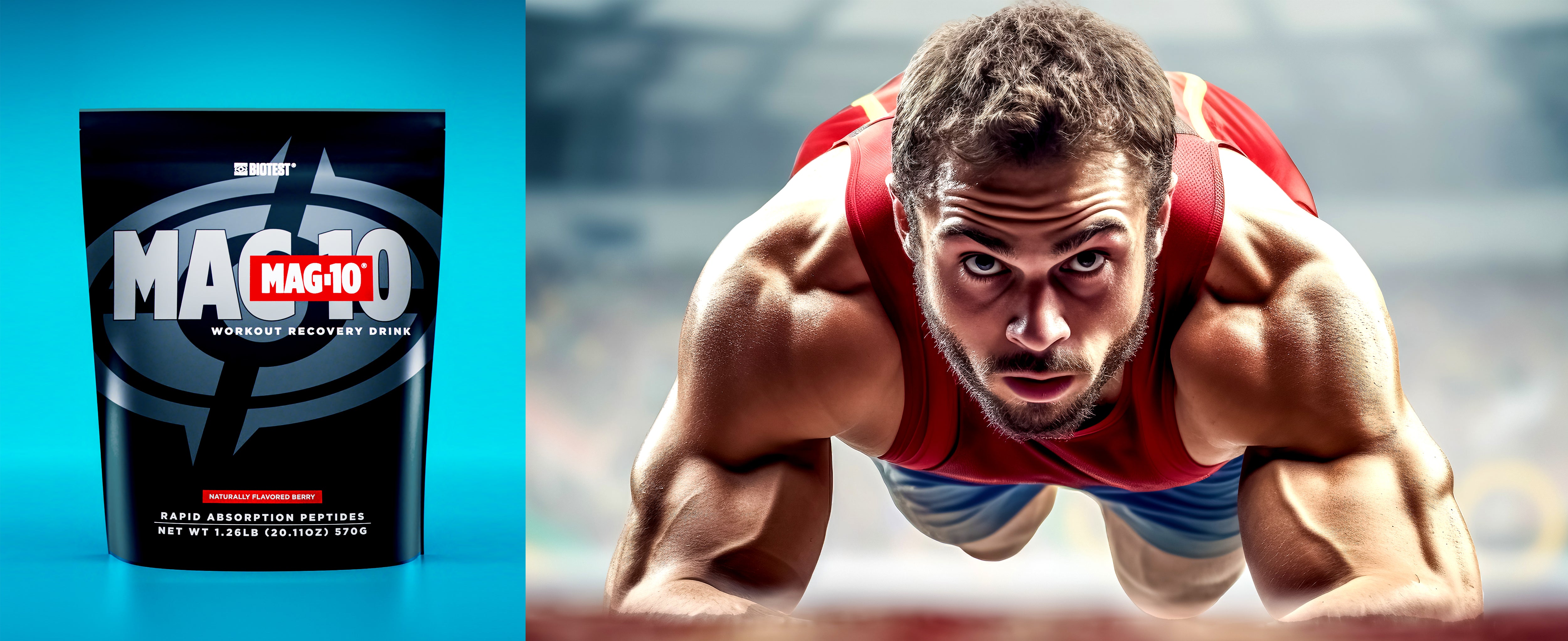
Do you need level 3 post-workout nutrition?
The answer depends on your training intensity, goals, and financial values. All we can do is provide the essential details so you can make an informed choice.
There are three levels of post-workout nutrition:
- Indiscriminate: consuming nutrients based on feel.
- Targeted: replenishing specific nutrients depleted during training and fueling muscle-protein synthesis.
- Elite: supplying the body with nutrients that intensify recovery and growth through accelerated muscle repair, enhanced protein synthesis, and fuel and support adaptive muscle/immune systems crosstalk activities.
- Rapid Absorption: MAG-10's casein hydrolysate is pre-digested into di- and tripeptides, absorbing more quickly than intact proteins and leading to faster delivery of amino acids to muscles.
- Muscle Recovery and Growth: MAG-10's rapid absorption aids muscle recovery and growth. After exercise, the quick supply of amino acids helps repair and build muscle tissue.
- High in Essential Amino Acids: MAG-10 is rich in essential amino acids, including leucine, crucial for muscle protein synthesis.
- Reduced Muscle Soreness: Studies show that the rapid uptake of MAG-10's casein hydrolysate helps minimize muscle soreness after intense workouts.
- Beneficial During Exercise: Unlike other protein sources, MAG-10's casein hydrolysate can be taken during exercise without causing discomfort, as it's rapidly absorbed and doesn't require extensive digestion.
- Enhanced Endurance Performance: Studies also show MAG-10's casein hydrolysate can improve endurance performance by reducing muscle damage and enhancing muscle recovery during prolonged exercise.
- Supports Immune Function: MAG-10's casein hydrolysate contributes to maintaining a healthy immune system, which is particularly beneficial for athletes undergoing intense training.
- Increases muscle gains by 70% over whey hydrolysate (Demling RH, 2000).
- Doubles fat loss over whey hydrolysate (Demling RH, 2000)
- Improves VO2max performance by 70% and reduces exercise-induced muscle soreness (Saunders MJ, 2009; Shirak T, 2015)
- Increases levels of powerful metabolic regulator FGF-21, improving insulin sensitivity in muscle (Fangmann D, 2020)
- Decreases stress hormone levels following exhaustive exercise (Suzuki K, 2014)*
- Enhances nutrient uptake in muscle (Iwasa M, 2020).
- Provides rapid hydration and nutrient loading without GI-tract distress (Takii H, 2004)*
MAG-10 is our level-3 solution. So, if you're a level-3 candidate and want to experience MAG-10's unparalleled effects, we've cut the price in half to make the decision easier to see what you've been missing.
Science-Based Benefits
Research
Recover Quicker and Grow Faster*

Stimulates High-Rate
Protein Synthesis*

Increases Nutrient
Uptake in Muscle*

Boost Metabolism
& Burns Fat*
- Boire Y et al. Slow and fast dietary proteins differently modulate postprandial protein accretion. Proc Natl Acad Sci USA. 1997, Dec 23;94(26):1493-5.
- Koopman R et al. Ingestion of protein hydrolysate is accompanied by an accelerated in vivo digestion and absorption rate when compared to its intact protein. Am J Clin Nutr. 2009 90: 106-115.
- Manninen A. Protein hydrolysates in sports nutrition, Nutrition and Metabolism. 2009 6:38 doi: 10.1186/1743-7075-6-38.
- Iwasa M et al. The milk casein hydrolysate-derived peptide enhances glucose uptake through AMP-activated protein kinase signaling pathway in skeletal muscle cells. Exp Physiol. 2020 Dec 28. PMID: 33369793 DOI: 10.1113/EP088770. New findings: What is the central question of this study? Previously, we have shown that supplementation of Lactobacillus helveticus-fermented milk and milk casein hydrolysate (MCH) improves glucose metabolism in exercised mice and humans. Common active ingredients contained in both Lactobacillus helveticus-fermented milk and MCH may enhance glucose metabolism, but the details are yet to be clarified. What is the main finding and its importance? MCH enhanced glucose uptake in skeletal muscle cells by stimulating AMP-activated kinase (AMPK), but not insulin signaling. Moreover, the MCH-derived specific peptide, Ile-Pro-Pro, mimicked this effect, suggesting a mechanism for the MCH-induced metabolic improvement. ABSTRACT: Improvement of glucose metabolism in the skeletal muscle has a key role in exercise performance and prevention of metabolic diseases. In our previous study, we had shown that intake of milk casein hydrolysate improves glucose metabolism in humans, but the mechanism of action was not elucidated. In this study, we aimed to investigate the mechanism of action of milk casein hydrolysate and its derived peptides on glucose uptake and glucose metabolic signaling in cultured skeletal muscle cells. Differentiated C2C12 myotubes were used for the experiments. The differentiated cells were incubated with milk casein hydrolysate, valine-proline-proline, and isoleucine-proline-proline. Subsequently, the rate of 2-deoxy-glucose uptake and the phosphorylation levels of insulin-dependent and -independent signaling factors were examined. We found that the rate of 2-deoxy-glucose uptake in both milk casein hydrolysate and isoleucine-proline-proline-treated cells was higher than that in the control cells. Immunoblotting assays showed that the phosphorylation levels of AMP-activated protein kinase, a rate-limiting factor in insulin-independent signaling, and that of liver kinase B1, an upstream factor of AMP-activated protein kinase, in both milk casein hydrolysate and isoleucine-proline-proline-treated cells were higher than those in the control cells. Such significant effects were not observed after treatment with valine-proline-proline. Moreover, the insulin-dependent signaling was not significantly affected under the different conditions. The findings of our study suggest that milk casein hydrolysate enhances glucose uptake by activating insulin-independent AMP-activated protein kinase signaling in skeletal muscle cells, which might be mediated by a milk casein hydrolysate-derived peptide, namely, isoleucine-proline-proline.
- Saunders MJ et al. Carbohydrate and protein hydrolysate coingestions improvement of late-exercise time-trial performance. Int J Sport Nutr Exerc Metab. 2009 Apr;19(2):136-49. PMID: 19478339 DOI: 10.1123/ijsnem.19.2.136. ABSTRACT: This study examined whether a carbohydrate + casein hydrolysate (CHO+ProH) beverage improved time-trial performance vs. a CHO beverage delivering approximately 60 g CHO/hr. Markers of muscle disruption and recovery were also assessed. Thirteen male cyclists (VO2peak = 60.8 +/- 1.6 ml . kg-1 . min-1) completed 2 computer-simulated 60-km time trials consisting of 3 laps of a 20-km course concluding with a 5-km climb (approximately 5% grade). Participants consumed 200 ml of CHO (6%) or CHO+ProH beverage (6% + 1.8% protein hydrolysate) every 5 km and 500 ml of beverage immediately postexercise. Beverage treatments were administered using a randomly counterbalanced, double-blind design. Plasma creatine phosphokinase (CK) and muscle-soreness ratings were assessed immediately before and 24 hr after cycling. Mean 60-km times were 134.4 +/- 4.6 and 135.0 +/- 4.0 min for CHO+ProH and CHO beverages, respectively. All time differences between treatments occurred during the final lap, with protein hydrolysate ingestion explaining a significant (p < .05) proportion of between-trials differences over the final 20 km (44.3 +/- 1.6, 45.0 +/- 1.6 min) and final 5 km (16.5 +/- 0.6, 16.9 +/- 0.6 min). Plasma CK levels and muscle-soreness ratings increased significantly after the CHO trial (161 +/- 53, 399 +/- 175 U/L; 15.8 +/- 5.1, 37.6 +/- 5.7 mm) but not the CHO+ProH trial (115 +/- 21, 262 +/- 88 U/L; 20.9 +/- 5.3, 32.2 +/- 7.1 mm). Late-exercise time-trial performance was enhanced with CHO+ProH beverage ingestion compared with a beverage containing CHO provided at maximal exogenous oxidation rates during exercise. CHO+ProH ingestion also prevented increases in plasma CK and muscle soreness after exercise.
- Demling RH et al. Increased protein intake during the recovery phase after severe burns increases body weight and muscle function. J. Burn Care Rehab. 1998;19:161-168.
- Demling RH et al. Effect of a hypocaloric diet, increased protein intake and resistance training on lean mass gains and fat mass loss in overweight police officers. Ann Nutr Metab. 2000;44(1):21-9. PMID: 10838463 DOI: 10.1159/000012817. ABSTRACT: We compare the effects of a moderate hypocaloric, high-protein diet and resistance training, using two different protein supplements, versus hypocaloric diet alone on body compositional changes in overweight police officers. A randomized, prospective 12-week study was performed comparing the changes in body composition produced by three different treatment modalities in three study groups. One group (n = 10) was placed on a nonlipogenic, hypocaloric diet alone (80% of predicted needs). A second group (n = 14) was placed on the hypocaloric diet plus resistance exercise plus a high-protein intake (1.5 g/kg/day) using a casein protein hydrolysate. In the third group (n = 14) treatment was identical to the second, except for the use of a whey protein hydrolysate. We found that weight loss was approximately 2.5 kg in all three groups. Mean percent body fat with diet alone decreased from a baseline of 27 +/- 1.8 to 25 +/- 1.3% at 12 weeks. With diet, exercise and casein the decrease was from 26 +/- 1.7 to 18 +/- 1.1% and with diet, exercise and whey protein the decrease was from 27 +/- 1.6 to 23 +/- 1.3%. The mean fat loss was 2. 5 +/- 0.6, 7.0 +/- 2.1 and 4.2 +/- 0.9 kg in the three groups, respectively. Lean mass gains in the three groups did not change for diet alone, versus gains of 4 +/- 1.4 and 2 +/- 0.7 kg in the casein and whey groups, respectively. Mean increase in strength for chest, shoulder and legs was 59 +/- 9% for casein and 29 +/- 9% for whey, a significant group difference. This significant difference in body composition and strength is likely due to improved nitrogen retention and overall anticatabolic effects caused by the peptide components of the casein hydrolysate.
- Fangmann D et al. Differential effects of protein intake versus intake of a defined oligopeptide on FGF-21 in obese human subjects in vivo. Clin Nutr. 2020 Jun 17;S0261-5614(20)30296-X. PMID: 32600859 DOI: 10.1016/j.clnu.2020.06.006. ABStrACT: Background: FGF-21 is described as a powerful metabolic regulator with beneficial effects including glucose-lowering and improvement of insulin sensitivity without hypoglycaemia. On the other hand, FGF-21 is activated when muscle and other tissues are stressed by external effects or internal cellular pathogens that lead to shortcomings in metabolic balance. Previous results suggested that FGF-21 could be a promising target to develop future metabolic therapeutics. Purpose: The present study was performed to gain deeper insight into the regulation of FGF-21 by protein metabolism in obese human subjects. Methods: FGF-21 serum concentrations were measured in a cohort of n = 246 obese humans ± type 2 diabetes mellitus (T2DM) (median age 53.0 [46.0; 60.0] years and BMI 40.43 [35.11; 47.24] kg/m2) and related to the nutritional protein intake. In addition, the effect of a novel oligopeptide purified from a β-casein hydrolysate on FGF-21 was examined in vitro in liver cells and in vivo in a human intervention study with the main focus on metabolic inflammation including 40 mainly obese subjects (mean age 41.08 ± 9.76 years, mean BMI 38.29 ± 9.4 kg/m2) in a randomized 20 weeks double-blind cross-over design. Main findings: In the cohort analysis, FGF-21 serum concentrations were significant lower with higher protein intake in obese subjects without T2DM but not in obese subjects with T2DM. Furthermore, relative methionine intake was inversely related to FGF-21. While global protein intake in obesity was inversely associated with FGF-21, incubation of HepG2 cells with a β-casein oligopeptide increased FGF-21 expression in vitro. This stimulatory effect was also present in vivo, since in the clinical intervention study treatment of obese subjects with the β-casein oligopeptide for 8 weeks significantly increased FGF-21 serum levels from W0 = 23.86 pg/mL to W8 = 30.54 pg/mL (p < 0.001), while no increase was found for placebo. Conclusion: While the total nutritional protein intake is inversely associated with FGF-21 serum levels, a purified and well characterised oligopeptide is able to induce FGF-21 serum levels in humans. These findings suggest a differential role of various components of protein metabolism on FGF-21, rather than this factor being solely a sensor of total nutritional protein intake.
- Cribb PJ et al. Effects of supplement timing and resistance exercise on skeletal muscle hypertrophy. Med Sci Sports Exerc. 2006 Nov;38(11):1918-25.
- Yuill KA et al. The administration of an oral carbohydrate-containing fluid prior to major elective upper-gastrointestinal surgery preserves skeletal muscle mass postoperatively - a randomized clinical trial. Clin Nutr. 2005 Feb;24(1):32-7.
- Welsh RS et al. Carbohydrates and physical/mental performance during intermittent exercise to fatigue. Med Sci Sports Exerc. 2002 Apr;34(4):723-31.
- Winnick JJ et al. Carbohydrate feedings during team sport exercise preserve physical and CNS function. Med Sci Sports Exerc. 2005 Feb;37(2):306-15.
- Davis JM et al. Carbohydrate drinks delay fatigue during intermittent, high-intensity cycling in active men and women. Int J Sport Nutr. 1997 Dec;7(4):261-73.
- Merson SJ et al. Rehydration with drinks differing in sodium concentration and recovery from moderate exercise-induced hypohydration in man. Eur J Appl Physiol. 2008 Jul;103(5):585-94.
- Mudambo SM et al. Body fluid shifts in soldiers after a jogging/walking exercise in the heat: effects of water and electrolyte solution on rehydration. Cent Afr J Med. 2001 Sep-Oct;47(9-10):220-5.
- Shirreffs SM et al. Rehydration and recovery of fluid balance after exercise. Exerc Sport Sci Rev. 2000 Jan;28(1):27-32.
- Galloway SD. Dehydration, rehydration, and exercise in the heat: rehydration strategies for athletic competition. Can J Appl Physiol. 1999 Apr;24(2):188-200.
- Brouns F et al. The effect of different rehydration drinks on post-exercise electrolyte excretion in trained athletes. Int J Sports Med. 1998 Jan;19(1):56-60.
- Sugiura K et al. Effect of carbohydrate ingestion on sprint performance following continuous and intermittent exercise. Med Sci Sports Exerc. 1998 Nov;30(11):1624-30.
- Ali A et al. The influence of carbohydrate-electrolyte ingestion on soccer skill performance. Med Sci Sports Exerc. 2007 Nov;39(11):1969-76.
- Kamel KS et al. Treatment of hyponatremia: a quantitative analysis. Am J Kidney Dis. 1993 Apr;21(4):439-43.
- Murray R. The effects of consuming carbohydrate-electrolyte beverages on gastric emptying and fluid absorption during and following exercise. Sports Med. 1987 Sep-Oct;4(5):322-51.
- Shiraki T et al. Evaluation of exercise performance with the intake of highly branched cyclic dextrin in athletes. Food Science and Technology Research. 2015 Volume 21 Issue 3 Pages 499-502. DOI: 10.3136/fstr.21.499. ABSTRACT: Highly branched cyclic dextrin (HBCD) is a novel type of maltodextrin with a narrow molecular weight distribution that is produced from starch. In this study, we investigated the effects of HBCD administration on endurance performance. Seven elite swimmers participated in three trials, conducted in random order. In each trial, the subjects received either HBCD, glucose (1.5 g carbohydrate/kg body weight) or water (as a control), and immediately carried out 10 cycles of intermittent swimming consisting of 5 min of swimming at 75% followed by 3 min of rest, and subsequent swimming at 90% to exhaustion. The time to fatigue was about 70% longer in the HBCD trial than that in the glucose and control trials, a significant difference. Plasma glucose in the HBCD group was maintained at higher levels during pre-swimming cycles than that in the glucose or water group. These results suggest that HBCD administration enhances endurance performance.
- Furuyashiki T et al. Effects of ingesting highly branched cyclic dextrin during endurance exercise on rating of perceived exertion and blood components associated with energy metabolism. Biosci Biotechnol Biochem. 2014;78(12):2117-9. DOI: 10.1080/09168451.2014.943654. ABSTRACT: We compared the effect of relatively low doses (15 g) of highly branched cyclic dextrin (HBCD) with that of maltodextrin during endurance exercise on the rating of perceived exertion (RPE) in a crossover, double-blind study of healthy volunteers. The RPE increased during exercise and its increase was significantly less at 30 and 60 min after ingesting HBCD than maltodextrin.
- Suzuki K et al. Effect of a sports drink based on highly-branched cyclic dextrin on cytokine responses to exhaustive endurance exercise. J Sports Med Phys Fitness. 2014 Oct;54(5):622-30. PMID: 25270782. ABSTRACT: Background: Aim of the present study was to compare the effects of highly branched cyclic dextrin (HBCD) drink with a glucose-based control drink on immunoendocrine responses to endurance exercise. Methods: Using a randomized, double-blind placebo-controlled cross-over design, seven male triathletes participated in two duathlon races separated by one month, consisting of 5 km of running, 40 km of cycling and 5 km of running. In the first race, four athletes consumed the HBCD-based drink and three athletes consumed the glucose-based drink. In the second race, three athletes consumed the HBCD-based drink and four athletes consumed the glucose-based drink. We collected blood and urine samples before and after the races to analyze leukocyte count and concentrations of hormones and cytokines. Results: Lymphocyte and neutrophil counts increased significantly after exercise in both trials (P < 0.05), but were not significantly different between the trials. Plasma noradrenalin concentration increased significantly (P < 0.05) during exercise in the glucose trial, but not in the HBCD trial. Plasma concentrations of interleukin (IL)-8 and IL-10 increased significantly during exercise in both trials (P < 0.05) but were not significantly different between the trials. Post-race urinary IL-8, IL-10 and IL-12p40 concentrations were significantly lower in the HBCD trial compared with the glucose trial (P < 0.05), although the plasma concentrations of these cytokines were not significantly different between both trials. Conclusion: These results suggest that the HBCD-based drink may attenuate the stress hormone response, and reduce the urinary cytokine levels following exhaustive exercise.
- Takii H et al. Fluids containing a highly branched cyclic dextrin influence the gastric emptying rate. Int J Sports Med. 2005 May;26(4):314-9. doi: 10.1055/s-2004-820999. ABSTRACT: The rates of gastric emptying for highly branched cyclic dextrin (HBCD) and other carbohydrate (CHO) solutions were examined using ultrasonograph techniques. Ten healthy volunteers ingested water, physiological saline, or solutions containing various CHO, such as HBCD, glucose, maltose, sucrose, and commercially available dextrin. After a subject drank one of the solutions, the relaxed cross-sectional area of the pylorus antrum was measured at rest by real-time ultrasonography. The time required for gastric emptying was correlated with the relaxed cross-sectional area of the pylorus antrum. Among all of the solutions tested, physiological saline was transferred fastest from the stomach to the small intestine. For solutions of the same CHO, 5% solution was transferred faster than 10% solution. For CHO solutions other than HBCD, a low osmotic pressure was associated with rapid transfer from the stomach. The gastric emptying time (GET) of HBCD solution increased with an increase in its concentration. A shorter GET was observed for the CHO solutions at 59 to 160 mOsm regardless of their concentration. A sports drink based on 10% HBCD adjusted to 150 mOsm by the addition of various minerals, vitamins, and organic acids was evacuated significantly (p < 0.05) faster than a 10% HBCD solution or a sports drink based on 10% commercially available dextrin (DE16), which has a higher osmotic pressure (269 mOsm). Our results suggest that a shorter GET could be achieved with CHO solutions with osmotic pressures of 59 - 160 mOsm. Therefore, a sports drink based on 10% HBCD adjusted to 150 mOsm by the addition of minerals, vitamins, and organic acids could supply adequate quantities of CHO, fluid, and minerals simultaneously in a short time, without increasing GET.
- Takii H et al. Enhancement of swimming endurance in mice by highly branched cyclic dextrin. Biosci Biotechnol Biochem. 1999 Dec;63(12):2045-52. DOI: 10.1271/bbb.63.2045. ABSTRACT: We investigated the ergogenic effect in mice of administering highly branched cyclic dextrin (HBCD), a new type of glucose polymer, on the swimming endurance in an adjustable-current swimming pool. Male Std ddY mice were administered a HBCD, a glucose solution or water via a stomach sonde 10 min before, 10 min after or 30 min after beginning swimming exercise, and were then obliged to swim in the pool. The total swimming period until exhaustion, an index of the swimming endurance, was measured. An ergogenic effect of HBCD was observed at a dose of 500 mg/kg of body weight, whereas it had no effect at a dose of 166 mg/kg of body wt (p < 0.05). The mice administered with the HBCD solution 10 min after starting the exercise were able to swim significantly longer (p < 0.05) than the mice who had ingested water or the glucose solution. The rise in mean blood glucose level in the mice administered with HBCD, which was measured 20 min after starting swimming, was significantly lower (p < 0.05) than that in the mice administered with glucose, although it was significantly higher (p < 0.05) than that in the mice administered with water. The mean blood insulin rise in the mice given HBCD was significantly lower (p < 0.05) than that in the mice given glucose. The mice administered with HBCD 30 min after starting the exercise swam significantly longer (p < 0.05) than the mice who had ingested water, although the enhancement of swimming time was similar to that of the glucose-ingesting mice. The gastric emptying rate of the HBCD solution was significantly faster (p < 0.05) than that of the glucose solution. However, this glucose polymer must have spent more time being absorbed because it has to be hydrolyzed before absorption, reflecting a lower and possibly longer-lasting blood glucose level. We conclude that the prolongation of swimming endurance in mice administered with HBCD depended on its rapid and longer-lasting ability for supplying glucose with a lower postprandial blood insulin response, leading to a delayed onset of fatigue.
- Amano T et al. Effects of isomaltulose ingestion on postexercise hydration state and heat loss responses in young men. Exp Physiol. 2019 Oct;104(10):1494-1504.
- de Groot E et al. Efficacy of Isomaltulose Compared to Sucrose in Modulating Endothelial Function in Overweight Adults. Nutrients. 2020 Jan 3;12(1):141.
- König D et al. Substrate Utilization and Cycling Performance Following Palatinose Ingestion: A Randomized, Double-Blind, Controlled Trial. Nutrients. 2016 Jul;8(7):390.
- Lightowler H et al, Changes in Weight and Substrate Oxidation in Overweight Adults Following Isomaltulose Intake During a 12-Week Weight Loss Intervention: A Randomized, Double-Blind, Controlled Trial. Nutrients. 2019 Oct 4;11(10):2367.
- Lina BAR et al. Isomaltulose (Palatinose®): a review of biological and toxicological studies. Food Chem Toxicol. 2002 Oct;40(10):1375-81.
- Miyashita M et al. The effects of isomaltulose ingestion on gastric parameters and cycling performance in young men. J Exerc Sci Fit. 2019 Jul;17(3):101-107.
- Reviews
- Questions
The good stuff
Surge/Mag 10 is a staple of my workout routine. It helps to keep alot of the soreness away.
Mag 10
Love the product. I feel more recovered and have never been leaner or bigger. Convenient and effective. Flavors are also real good.
Not Done Yet
I finish every workout with Mag-10. It does make a difference. If you finish your workout and you're not doing a Mag-10, you're NOT DONE YET!
Never Train without it & Surge
The ingredients speak for themselves and the bio availability is a game changer in your training sessions. Don't take my word for it. Get on the Mag-10 train and stop spinning your wheels with junk.
One of my favorites
Mag-10 is one of my favorite supplements. My recovery and progress is dramatically improved when I use it post-workout and between meals as a pulse. Love it!
Good product for extra protein and minerals
Mixes well with water, very convenient and good ratio of protein/carbohydrates for the price. I appreciate the extra bottle now provided with the flavoring mix. My one critique would be getting away from Splenda as an artificial sweetener. It probably isn't healthy long term, and doesn't improve the flavor.
Great addition to my fitness/ nutrition regimen
Mag-10 is a unique product. It provides the needed protein supplementation after my workouts, tastes great and is easily digested. It has definitely made a difference in helping me add muscle and strength over the last six weeks and compliments my nutrition program.
Glad it's Back!
Love Mag-10, have been a fan for a while. Was bummed when it was unavailable during the pandemic, so I'm glad it's back in stock! My muscles are less sore when I train with Mag-10 and it doesn't give me any stomach bloat/gas like whey does. Highly recommend this to any serious lifter.
MAG -10 is BACK !!
I loved having MAG - 10 back in my nutritional program! I have missed it over the years! Still get is done !! Thanks BIOTEST for amazing top notch Supplements for the HARDCORE
Keep selling it
I think it’s one of the best products from Biotest. I love doing MAG 10 pulses and taking it after workouts and before bed.
You may also like
*These statements have not been evaluated by the Food and Drug Administration. This product is not intended to diagnose, treat, cure, or prevent any disease.
